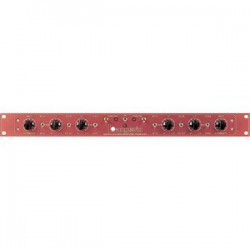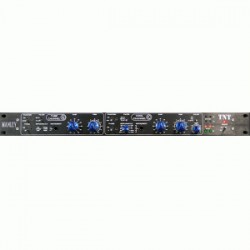Danh mục tin
Pure . . . Your most important tracks deserve this.
The MANLEY all-tube microphone preamplifiers are available in 2-channel or single channel versions, primarily intended for use with modern capacitor (condenser) microphones. Now, 40 to 60 dBs of gain, enough for most ribbon mics, are selectable in precise 5dB steps by varying the amount of overall negative feedback on the GAIN switch. This is a very interesting feature indeed, allowing you to change the slew rate (speed), placement, and tonal balance of the sound from mellow and "tubey-er" through to faster, punchier and more aggressive. See "Notes on Variable Feedback" for more info.
Tube complements are common to both models: 1 x 12AX7EH hand-selected for lowest noise, and 1 x 6414 for each high-current output stage. Each unit is painstakingly hand wired using silver solder and audiophile-grade componentry. Double shielded custom-built power transformers and custom-built high capacity reservoir capacitors demonstrate our modern power supply design approach.
The front panel 1/4" DIRECT INPUT jack makes these preamplifiers serve double duty as a pure tube line stage for instruments such as bass, drum machines, and keyboards when you need to get your tunes through some tubes before hitting a sterile digital recorder. Total gain in this mode becomes 20dB less than indicated on the GAIN switch. Both transformer coupled balanced and direct (via humongous metalized film MultiCaps) capacitor coupled unbalanced outputs are provided giving you the choice of audiophile-purist or big iron sounds. Perennial shoot-out winners, our single-ended preamp designs have become favorites among top engineers and home recordists alike looking for "that rich Manley sound with the tight bass and the top end that goes on forever" which begs to go direct to tape.
It's a BIG sounding micpre!
Features & Specifications
Manley All Tube Microphone Preamplifiers - Mono or Dual Mono models available (specs same for both)
- MANLEY input & output transformers with nickel laminations in mu-metal cases
- Flat frequency response from 10Hz-60KHz
- Mic input PHASE REVERSE switch
- 2400 Ohm mic input Z; 48V phantom power built-in
- Hi-Z (100 kOhm) 1/4" DIRECT INPUT
- Noiseless conductive plastic INPUT attenuators
- EIN: -125dB
- Adjustable FEEDBACK / GAIN switch selects 5dB steps between 40 to 60 dB of gain
- Hi-current driveShipping Weight: 12 lbs.
Manufacturer's Suggested Retail Price
- Mono Microphone Preamplifier Monoblock: $2,200
- Dual-Mono 40 dB Microphone Preamplifier: $3,300
Manley All Tube Mic Pre's FAQ's
FAQ #1: I've experimented with both the unbalanced and the balanced outputs, and I like them both. Now that I know what they both sound like, I'd ideally like to use the xfmr outputs for certain types of sounds and the unbalanced outputs for other things, but I noticed that the XLR output gets muted when I plug in a 1/4" cable to the unbalanced out... makes it impossible to route them both to a patch bay...
So, hey, not to hassle you or anything, but I'm wondering if there's a technical reason why it would be a bad idea to have both the XLR and 1/4" outputs active simultaneously?
A couple of reasons: if you connected a lo-z load on both the 1/4" and theXLR at the same time, you would load down the output excessively and raisedistortion; also, without the switching jack, the primary of the output transformer would still be in the circuit so it would sound different out of the unbalanced output than it does now. The 1/4" jack disconnects the transformer primary when plugged into.
FAQ #2: I will soon buy a Mic preamp. The Dual Mono Mic Preamp could be the right one. But it is very important for me, to chose a Preamp that I can use for different things. Can I use the Dual Mono Mic Preamp to warm up my recorded digital tracks too?What is the Difference to the Dual Mono Tube Direct Interface? Can I use the Mic Preamp as DI too?
Yes you can pass a line level signal into the Manley Dual Mono Mic Preamp via the Direct Inputs and come out the XLRs to get the sound of tubes and the output transformer. If you keep the gain at the lower settings (with most global feedback being used) then you also have more rich sound which might be the thing you are looking for to warm up your digital tracks.
Yes of course you can use the Manley Dual Mono Mic Preamp as a DI. That's what the front panel Direct Inputs are there for! Bass players especially like the sound of our Mic Preamp DI circuits on the stand-alone micpreamps as well as the ones on the VOXBOX®. There is 20 to 40dB of gain available on those DI jacks.
The Tube Direct Interface has no gain. It is specifically for instruments passing through it to get from high impedance to low impedance for low noise and to be used as a splitter for the 1/4" to feed an amp head while the XLR goes to the console (or external mic preamp) MIC INPUT. You would use a Tube Direct Interface in addition to a Microphone Preamplifier.
Cheers,
EveAnna Manley
Older Version Identification Guide
Here is a mini Manley micpreamp identification guide, in case anyone else is a-wonderin':
The oldest version of "40dB Mono Microphone Preamplifier"was built from 1991 to 1993 at the old VTL factory:
Gain was 3 positions 40-45-50.
They had a rotary phantom power switch (which would be replaced by a big toggle switch when it broke like in the example below.)They were in the older steel "tray" chassis with a stainless-steel top as pictured below.
 |
VTL-built older "Dual Mono Microphone Preamplifier" were built in an aluminum "tray" chassis.
Some (most?) of these VTL-built units used 6350 for the output tube which has a different pinout compared to 12BH7A or 6414.
Here is an example of a really old VTL-built "Dual-Mono Microphone Preamplifier"(Spotted this on on eBay 4/2009)
Note the five position "Variable Feedback" (aka GAIN) control.
 |
The ones we built here at Manley Labs physically look like the current models.They are in the "extruded side chassis" with removable perforated top and bottom.All use 6414 as the output tube.
   |
The older "40dB" named mono units looked like these. Later, front panel Direct Inputs were added. Gain on these older units was 40-42.5-45-47.5-50dB.
We upped the gain from 40-42.5-45-47.5-50
TO
40-45-50-55-60 in the latest version.
If there is an X in the serial number, then it is the latest version. TheHigher gain version went into production 8/2000.Serial codes are 40MP(B) or (X) ### for the mono.
DMMP### older dual channel version 6072A + 6414
DMMPB### Balanced Outs 6072A + 6414
DMMPX### and higher gain 12AX7A + 6414
They are all basically the same circuit. Higher gain is useful for ribbons. But yes with reduced feedback and higher gain you get a little more noise and more aggressive sound. At the 40dB position the EIN is -125dB which ain't half bad, folks.
Older models are.... just older. The basic circuit hasn't changed much over the years.
Current models are called "Manley Mono Microphone Preamplifier" and "Manley Dual Mono Mic Pre". We don't call 'em "40dB anything" anymore.
There was another model in a 1RU chassis with an extra tube stage called "Reference Microphone Preamplifier" built at the VTL factory from 1989 to 1992 and later a 1 1/2 RU version of this called "60dB Microphone Preamplifier"that was built for the first few years at the Manley Labs factory from 1993 to 1995. These models have been out of production for a very long time.
The "Reference Microphone Preamplifiers" were born as a response to a request by a large organization who were shooting out any and all of the best mic preamps available at the time (late 1988, early 1989). This one won the shootout and they ordered 60 pieces of 'em and consequently launched the Manley Pro Gear division, then at VTL. So yes, this was Manley's very first pro studio model.
The first version of the "Reference Microphone Preamplifier" had a torroid transformer and tube-regulated B+ rail living behind the power switch. These proved not-so-reliable and actually unnecessary so later versions had that stuff ripped out and traditional solid-state rectification and pi-filtering without B+ regulation installed instead. Heaters were regulated with a TO-3 7812 solid state 12 volt regulator mounted to the rear of the chassis. Most of these units did not have built-in phantom supplies, although some did via provide phantom power by way of some zener diodes bringing some 48 volts into the orange center tap of the Sowter input transformer's primary. Units that did not have the Phantom switch had a Direct Input installed instead, as seen in the example below. That large organization was Pin 3 Hot at the time, so a lot of these might still be Pin 3 hot, unless I have gotten to 'em since and changed them.
As mentioned above, these units had an additional first amplifying stage using a 6072 in cascade. After that, the signal hit the attenuator, (it went to up to 13) and then into a 12AU7 cascaded stage before hitting the final 12AT7 cathode follower output stage which provided an unbalanced output via XLR and RCA jacks in parallel. The Variable Feedback 5 position switch did exactly that (varied the amount of global feedback around the second stage) and provided 8dB of feedback and gain change in 2dB steps.
This unit was housed in a black powder coated steel chassis with a stainless steel top. There was no silk-screening on the rear of the chassis. P-touch labels if you were lucky.
Here is a VTL-Built "Reference Microphone Preamplifier" front and rear views.
 |
After Manley split out of the VTL factory in 1993, there were some 1 1/2 RU versions of the "60dB Microphone Preamplifiers" built in billet aluminum chassis also using a similar circuit to the older 1U model.
If you have a good photo of any of these antiquities, please send it to EveAnnaand she'll put it up here for everyone.




